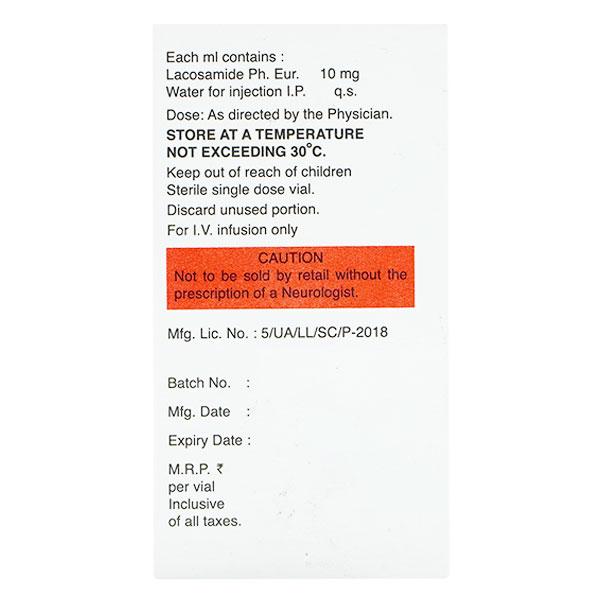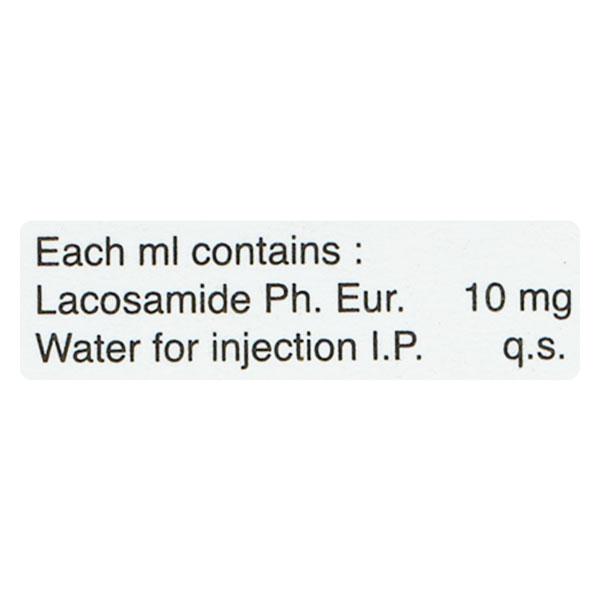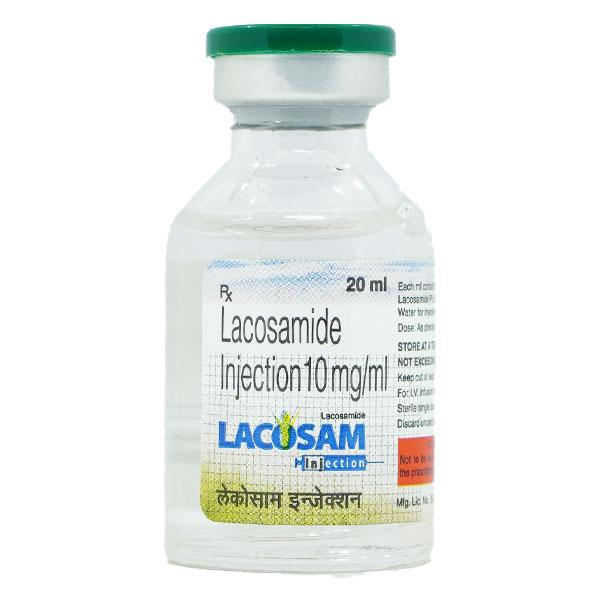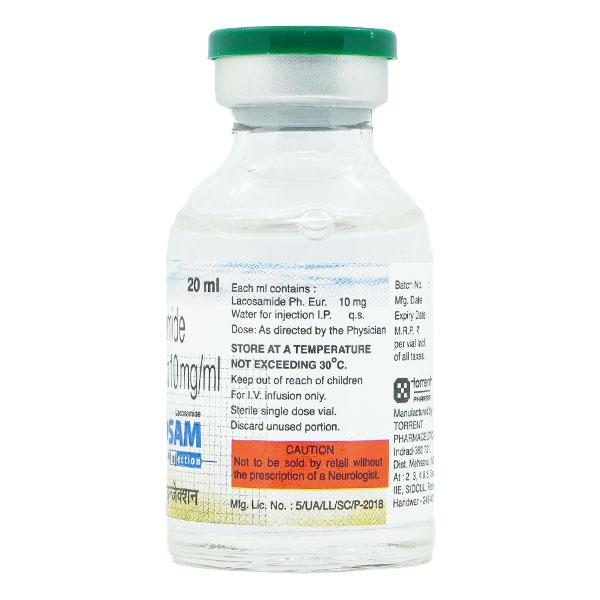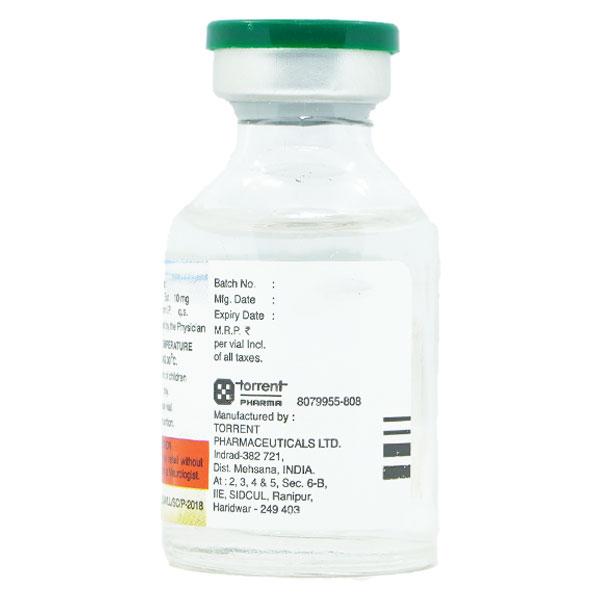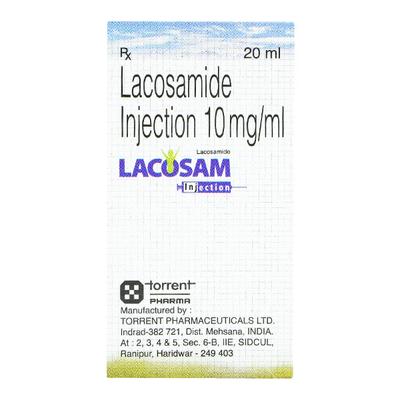

Netmeds First Membership
Quick Links
Introduction About LACOSAM INJECTION
LACOSAM INJECTION contains Lacosamide which belongs to the group of medicines called Antiepileptics. It is used as an adjunctive management of partial onset seizures in patients above 17 years of age.
Epilepsy is a neurological disorder of the central nervous system in which the brain activity becomes abnormal, causing seizures or periods of unusual behavior, sensations and sometimes loss of awareness.
Before receiving LACOSAM INJECTION, inform your doctor if you have or ever had a certain type of heartbeat problem called second or third-degree AV block. Your doctor will prescribe the right dose depends on your child’s age, body weight and disease condition. Consult your doctor before receiving the medicine.
LACOSAM INJECTION is not recommended to use among women who are pregnant or breastfeeding. The most common side effects of receiving LACOSAM INJECTION are headache, nausea and double vision. Contact your doctor if any of the symptoms worsen.
Uses Of LACOSAM INJECTION
- Used as an adjunctive management of partial onset seizures in patients above 17 years of age
How LACOSAM INJECTION Works
LACOSAM INJECTION works slowly by inactivating the sodium gated channels, which decreases the abnormal and excessive activity of the nerve cells in the brain and controls seizures or fits.
How to use LACOSAM INJECTION
LACOSAM INJECTION will be administered to you into a vein only by a doctor or a nurse. Your doctor will administer the correct dose and duration for you depending upon your age, body weight and disease condition.
Side Effects Of LACOSAM INJECTION
Common
- headache
- pain or discomfort or irritation at the site of injection
- nausea
- double vision
- myoclonic seizures (short jerks of a muscle or group of muscles)
- difficulties in coordinating movements or walking
- problems in keeping balance, tremors (shaking), tingling (paresthesia) or muscle spasms, falling easily and getting bruises
- troubles with memory, thinking or finding words, confusion
- blurred vision, rapid and uncontrollable movements of the eyes (nystagmus)
- vertigo (a spinning sensation), feeling drunk
- vomiting, dry mouth, constipation, indigestion, excessive gas in the stomach or bowel, diarrhea
- reduced sensitivity or feeling, difficulty in articulating words, disturbance in attention
- noise in the ear such as buzzing, ringing or whistling
- irritability, trouble sleeping, depression
- sleepiness, tiredness or weakness
- itching, rash
- runny nose, fever, sore throat, eating less than usual (in children)
Uncommon
- hallucinations
- blood tests might show abnormal liver function, liver injury
- self-harming thoughts
- feeling angry or agitated
- swelling of the face, throat, hands, feet, ankles or lower legs and hives
- fainting
- abnormal involuntary movements
- feeling sleepy or lacking in energy
- redness at the site of injection
Rare
Stop receiving LACOSAM INJECTION and contact your doctor immediately if you experience any of the following side effects:
- symptoms of abnormal heartbeat (such as rapid, irregular or slow heartbeat, palpitations, shortness of breath, feeling lightheaded, fainting)
How To Manage Side Effects
Nausea or Vomiting:
Receive this medicine with or just after meals. Stick to simple meals. Avoid eating oil-rich or spicy foods.
Diarrhea:
Drink a lot of fluids such as water or fruit juice to keep yourself hydrated. Do not consume any medicine on your own without consulting your doctor.
Constipation:
Eat plenty of fiber-rich foods such as fresh fruits, vegetables and cereals and drink plenty of water. Exercise more regularly.
Warning & Precautions
Pregnancy
LACOSAM INJECTION is generally not recommended for use in pregnant women unless considered clearly necessary. Consult your doctor before receiving the medicine.
Breastfeeding
LACOSAM INJECTION is generally not recommended for use in breastfeeding women as it may pass through breast milk. Consult your doctor before receiving the medicine.
Driving and Using Machines
Do not drive or operate any machines if you feel dizzy or blurred vision after receiving LACOSAM INJECTION.
Alcohol
Avoid consumption of alcohol while receiving LACOSAM INJECTION. Consult your doctor for advice.
Kidney
LACOSAM INJECTION should be used with caution in patients with kidney problems. Consult your doctor before receiving the medicine.
Liver
LACOSAM INJECTION should be used with caution in patients with liver problems. Consult your doctor before receiving the medicine.
Allergy
Do not receive LACOSAM INJECTION if you are allergic to Lacosamide or any of the other ingredients of the medicine.
Heart Disease
LACOSAM INJECTION is not recommended for use in patients with heartbeat problems like second or third-degree AV block and LACOSAM INJECTION should be used with caution in patients with AV block, atrial fibrillation, atrial flutter, heart failure or who have had a heart attack. Consult your doctor before receiving the medicine.
Others
Before receiving LACOSAM INJECTION, inform your doctor if you have:
- self-harming thoughts
- often dizzy or fall over
Use in pediatrics:
LACOSAM INJECTION is not recommended for use in children aged under 4 years due to lack of data. Consult your doctor before receiving the medicine.
Use in geriatrics:
LACOSAM INJECTION should be used with caution in elderly patients (aged 65 years and above). Consult your doctor before receiving the medicine.
Interactions
A. Drug-Drug interactions:
Before receiving LACOSAM INJECTION, inform your doctor if you are taking any of the following medicine:
- medicines used to manage heart problems
- medicines used to manage epilepsy or pain (Ex. carbamazepine, lamotrigine or pregabalin)
- medicines used for fungal infections (Ex. fluconazole, itraconazole or ketoconazole)
- medicine used to manage HIV (Ex. ritonavir)
- medicines used to manage bacterial infections (Ex. clarithromycin or rifampicin)
- herbal medicine used to manage mild anxiety and depression (Ex. St. John’s wort)
Overdosage:
LACOSAM INJECTION will be administered to you only by a doctor or a nurse in a hospital and so it is unlikely to receive an overdose. However, consult your doctor or nurse if you experience any unusual symptoms.
Synopsis
| Drug | : | Lacosamide |
| Pharmacological Category | : | Antiepileptics |
| Therapeutic Indication | : | Epilepsy |
| Dosage Forms | : | Tablet, Injection, Syrup |
More Information
- Keep LACOSAM INJECTION out of reach of children
- Store at a temperature below 25°C
FAQs About LACOSAM INJECTION
LACOSAM INJECTION is used for?
LACOSAM INJECTION is used to manage epilepsy. Epilepsy is a neurological disorder of the central nervous system in which the brain activity becomes abnormal, causing seizures or periods of unusual behavior, sensations and sometimes loss of awareness.
What are the common side effects of LACOSAM INJECTION?
The most common side effects of receiving LACOSAM INJECTION are headache, nausea and double vision. Contact your doctor if any of the above symptoms worsen.
What happens if I receive too much of LACOSAM INJECTION?
LACOSAM INJECTION will be administered to you only by a doctor or a nurse in a hospital and so it is unlikely to receive an overdose. However, consult your doctor or nurse if you experience any unusual symptoms.
Is it safe to receive LACOSAM INJECTION if am pregnant?
LACOSAM INJECTION is not recommended to use in pregnant women unless it is considered clearly necessary. Consult your doctor before receiving the medicine.
Can LACOSAM INJECTION be used in patients with bacterial infections?
No. LACOSAM INJECTION should not be used with anti-bacterial as it causes drug-drug interaction. Inform your doctor before starting the management with LACOSAM INJECTION.
Can I stop LACOSAM INJECTION if my condition improves?
Do not stop LACOSAM INJECTION even if your condition improves, because there is a chance of epilepsy coming back again or becoming worse. Consult your doctor before stopping the management.
Is LACOSAM INJECTION safe to use in older people?
LACOSAM INJECTION should be used with caution in elderly patients (aged 65 years and above). Consult your doctor before receiving the medicine.
References
1. Misty D. Smith, Cameron S. Metcalf and Karen S. Wilcox. Pharmacotherapy of the Epilepsies. Goodman & Gilman’s: The Pharmacological basics of Therapeutics. 13th Edition. New York McGraw Hill Medical 2018 Page – 303-326.
2. Liyan Hou, Bingjie Peng, Defu Zhang, Jingjing Yang, Ying Wang, Li Tong, Sheng Li, Qingshan Wang1 and Jie Zhao. Clinical Efficacy and Safety of Lacosamide as an Adjunctive Treatment in Adults with Refractory Epilepsy. Frontiers in neurology. December 2021. [Accessed on 21st May] https://www.frontiersin.org/articles/10.3389/fneur.2021.712717/full
3. Jon Allard, William Henley, Brendan Mclean, Sunil Ram, Manny Bagary, Rohit Shankar. Lacosamide in the general population and in people with intellectual disability: Similar responses? European Journal of Epilepsy. March 2020. [Accessed on 21st May] https://www.seizure-journal.com/article/S1059-1311(20)30054-6/fulltext
4. G. L. Krauss. Lacosamide for the treatment of epilepsy. Taylor and Francis online. June 2011. [Accessed on 21st May] https://www.tandfonline.com/doi/full/10.3109/07853890.2011.603700
5. UCB Pharma Limited. Electronic Medicines Compendium (EMC). [Revised in December 2021] [Accessed on 21st May] https://www.medicines.org.uk/emc/files/pil.2286.pdf











